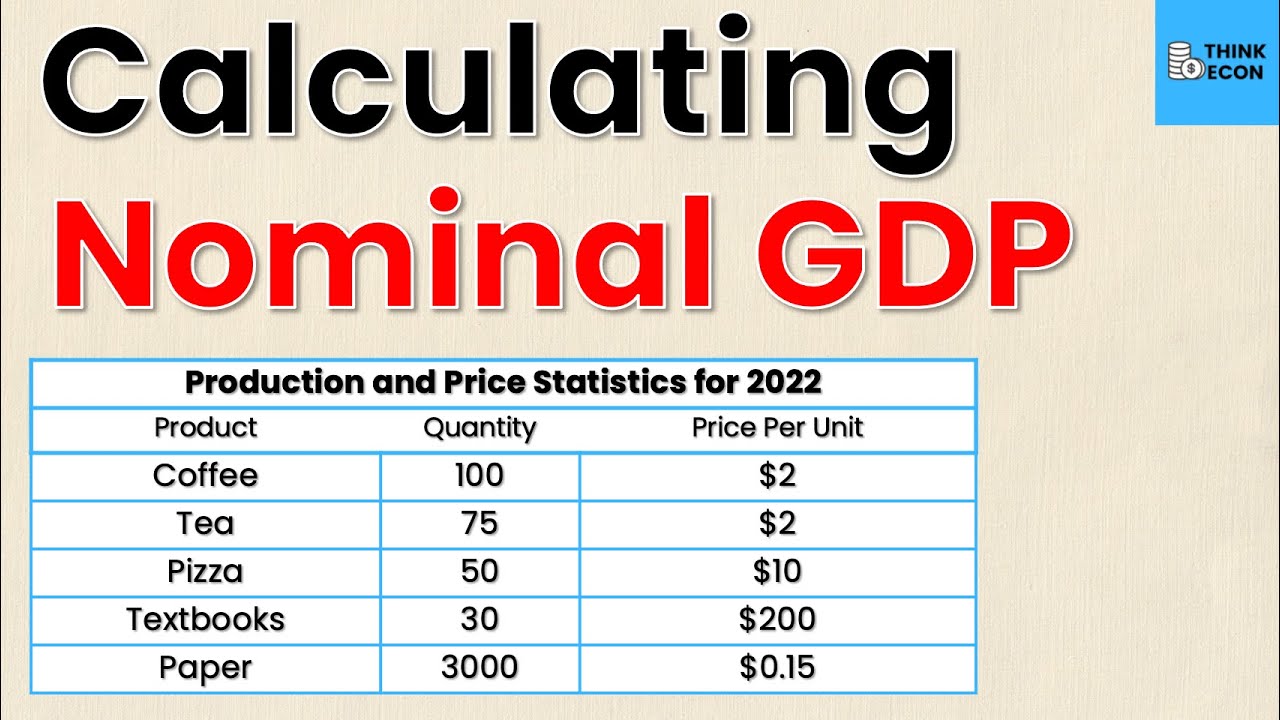
Are you struggling to understand how to find nominal GDP? Look no further! In this article, we will explain the concept of nominal GDP and guide you through the process of calculating it.
From understanding the components of nominal GDP to accounting for imports and exports, we’ll cover it all.
By the end, you’ll have a clear understanding of the difference between real and nominal GDP, and the limitations of measuring nominal GDP.
Let’s dive in!
The Definition of Nominal GDP
To understand nominal GDP, you need to know that it represents the total value of all goods and services produced within a country’s borders in current prices. It’s an important economic indicator that measures the size of an economy.
Nominal GDP includes both the prices and quantities of goods and services produced, providing a measure of the overall economic activity in a country. It’s calculated by multiplying the quantity of each good or service produced by its respective price and summing up these values across all sectors of the economy.
Nominal GDP is often used to compare the economic performance of different countries or to track the growth of an economy over time. It’s an essential tool for policymakers, investors, and economists in analyzing and understanding the state of an economy.
Components of Nominal GDP
To calculate nominal GDP, you’ll need to add up the value of all final goods and services produced within a country’s borders.
The components of nominal GDP include consumption, investment, government spending, and net exports.
Consumption refers to the total expenditure by households on goods and services.
Investment includes spending on capital goods, such as machinery and equipment, as well as residential and non-residential construction.
Government spending comprises the expenditure by the government on goods and services, such as infrastructure and public services.
Net exports represent the difference between a country’s exports and imports.
It’s important to consider all these components when calculating nominal GDP, as they provide a comprehensive measure of the overall economic activity within a country.
Understanding Price Level in Nominal GDP Calculation
When calculating nominal GDP, it’s important for you to understand the price level and its impact on the overall calculation. The price level refers to the average prices of goods and services in the economy. It’s measured using a price index, such as the Consumer Price Index (CPI) or the GDP deflator.
The price level is crucial in calculating nominal GDP because it allows for the adjustment of the value of goods and services over time. As prices change, the quantity of goods and services produced may stay the same, but their value in monetary terms will vary. By accounting for changes in the price level, nominal GDP reflects the current value of production and provides a more accurate measure of economic activity.
Calculating Government Expenditure in Nominal GDP
By including government expenditure in nominal GDP, you accurately account for the amount of money spent by the government on goods and services within the economy. Calculating government expenditure is relatively straightforward. It involves summing up all the spending by the government on public goods and services during a specific period, such as a year.
This includes expenses on infrastructure, defense, education, healthcare, social welfare programs, and more. To obtain accurate figures, it’s crucial to include all levels of government spending, including federal, state, and local.
Government expenditure is an essential component of nominal GDP as it represents the demand for goods and services by the public sector. By including it, economists can have a comprehensive understanding of the overall economic activity within a country.
How to Account for Imports and Exports in Nominal GDP
Now let’s talk about how imports and exports are accounted for in nominal GDP.
It’s important to consider the impact of the trade balance on the overall GDP figure. When a country’s imports exceed its exports, it can lead to a trade deficit, which can affect the nominal GDP negatively.
Additionally, fluctuations in currency exchange rates can also have an impact on the value of imports and exports, further influencing the calculation of nominal GDP.
Trade Balance Impact
To accurately calculate nominal GDP, you need to consider the impact of the trade balance on imports and exports.
The trade balance is the difference between a country’s exports and imports. When a country exports more goods and services than it imports, it has a trade surplus. This surplus contributes positively to the country’s nominal GDP.
On the other hand, when a country imports more than it exports, it has a trade deficit. This deficit negatively affects the country’s nominal GDP.
The trade balance impact is an important factor to consider when analyzing a country’s economic performance. It provides insights into the competitiveness and strength of its domestic industries, as well as its overall position in the global market.
Currency Exchange Rates
You can account for imports and exports in nominal GDP by considering the currency exchange rates. Currency exchange rates play a crucial role in determining the value of goods and services traded between countries.
When calculating nominal GDP, you need to convert the value of imports and exports into a common currency. This is because each country uses its own currency to measure its economic output. By using exchange rates, you can convert the value of imports and exports into the currency of the country where the GDP is being calculated.
This allows for a more accurate representation of the economic activity and ensures that the value of imports and exports is properly accounted for in the calculation of nominal GDP.
Real GDP Vs. Nominal GDP: Understanding the Difference
Now let’s talk about the difference between real GDP and nominal GDP. Understanding this difference is crucial because it helps us accurately measure the economic impact of inflation.
Real GDP takes into account changes in prices over time, giving us a more accurate picture of economic growth.
On the other hand, nominal GDP only measures the total value of goods and services produced without adjusting for inflation.
Defining GDP Measures
When calculating GDP, it’s important to understand the difference between real GDP and nominal GDP. Real GDP takes into account changes in price levels over time, allowing for a more accurate measure of economic growth. It’s adjusted for inflation, which means that it reflects changes in the quantity of goods and services produced, rather than changes in their prices.
On the other hand, nominal GDP doesn’t account for changes in price levels and is calculated using current market prices. While nominal GDP provides a snapshot of the current value of goods and services produced, it doesn’t provide an accurate representation of economic growth when comparing different time periods.
Understanding the difference between these two measures is crucial for policymakers and economists to make informed decisions and assess the true state of the economy.
Economic Impact of Inflation
Understand the distinction between real GDP and nominal GDP to grasp the economic effects of inflation.
Real GDP takes into account changes in prices over time, while nominal GDP does not.
When there’s inflation, the value of money decreases, causing prices of goods and services to rise. This leads to an increase in the nominal GDP because it reflects the higher prices.
However, the real GDP adjusts for inflation, providing a more accurate measure of economic growth.
When comparing real GDP to nominal GDP, you can see the impact of inflation on economic performance.
If real GDP is growing faster than nominal GDP, it indicates that the economy is experiencing deflation.
On the other hand, if nominal GDP is growing faster than real GDP, it suggests that inflation is occurring.
Understanding this difference is crucial for analyzing the true economic impact of inflation.
Limitations and Critiques of Nominal GDP Measurement
You may encounter some limitations and critiques when measuring nominal GDP.
One limitation is that nominal GDP doesn’t take into account changes in prices. This means that if the overall price level increases due to inflation, the nominal GDP may overstate the growth of the economy.
Additionally, nominal GDP doesn’t account for changes in the quality of goods and services produced. For example, if a product becomes more expensive but also improves in quality, nominal GDP may not accurately reflect the increase in value.
Critics argue that focusing solely on nominal GDP can lead to misleading conclusions about the health of an economy.
Therefore, it’s important to consider these limitations and critiques when using nominal GDP as a measure of economic performance.
Frequently Asked Questions
How Does Nominal GDP Affect Inflation and Purchasing Power?
Nominal GDP affects inflation and purchasing power by measuring the total value of goods and services produced in an economy. When nominal GDP increases, it can lead to inflation and a decrease in purchasing power.
Is There a Difference in Calculating Nominal GDP for Developed and Developing Countries?
There is a difference in calculating nominal GDP for developed and developing countries. It depends on the level of economic development, infrastructure, and data availability in each country.
Can Nominal GDP Be Used to Measure the Standard of Living in a Country?
Yes, nominal GDP can be used to measure the standard of living in a country. It represents the total value of goods and services produced, providing insight into a country’s economic activity and potential welfare.
What Are the Implications of Changes in the Exchange Rate on Nominal Gdp?
Changes in the exchange rate can have implications on nominal GDP. For example, if a country’s currency depreciates, it can lead to an increase in nominal GDP as the value of goods and services produced in that country will be higher when converted to another currency.
Are There Any Alternative Measures to Nominal GDP That Provide a More Accurate Representation of Economic Growth?
There aren’t any alternative measures to nominal GDP that provide a more accurate representation of economic growth. However, you can consider using real GDP or per capita GDP to gain a better understanding of the overall economic performance.
Conclusion
So there you have it, finding nominal GDP is a crucial aspect of understanding the economic performance of a country. By considering various components such as government expenditure, imports, and exports, we can calculate the total value of goods and services produced.
However, it’s important to note the limitations and critiques of this measurement.
Overall, nominal GDP provides valuable insights into a country’s economic activity and is an essential tool for policymakers and economists.







